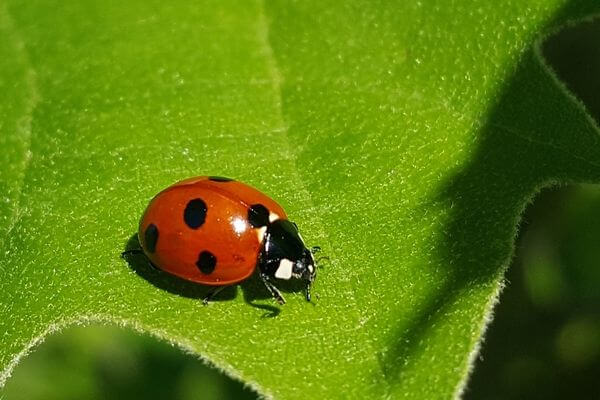Ladybugs are charming little insects that play a key role in pest control. With their vibrant colors and distinctive spots, they are popular with gardeners and farmers alike for their effectiveness in combating unwanted insects. In this article, we’ll explore their behavior, benefits, and conservation methods.

Ladybugs: An Overview
Ladybugs belong to the Coccinellidae family and are found all over the world, with an incredible diversity of species. Its most distinguishing features are its colorful wings, usually with black dot patterns on a red, orange or yellow background. However, not all of them feature these typical colors and patterns.
The Ladybug Diet
Ladybugs are voracious predators and feed mainly on small insects such as aphids, mealybugs, mites and larvae of other insects harmful to plants. Their diet is mainly composed of agricultural pests, making them valuable allies in the natural control of these undesirable organisms. A single adult ladybug can consume dozens of pests a day, significantly reducing their population in a short period of time.
How do they fight pests?
Ladybugs have strong, sharp jaws that allow them to capture and devour their prey quickly. In addition, they have the ability to secrete a sticky substance through their joints, allowing them to easily attach to surfaces and capture their prey efficiently.
Another notable feature is its ability to fly. This ability gives them mobility to find and reach areas infested by pests. In addition, they are known for their ability to emit an unpleasant odor when threatened, which protects them from natural predators.
Benefits for Agriculture
The presence of ladybugs in agricultural areas brings numerous benefits. By feeding on pests, they help reduce the need for chemical pesticides, promoting more sustainable and environmentally friendly agriculture. In addition, the use of ladybugs as biological control agents contributes to the preservation of biodiversity, as it does not affect other beneficial species present in the ecosystem.
Conservation Methods
To ensure the presence and effectiveness of ladybugs as allies in pest control, it is essential to adopt conservation measures. Some practices that can be implemented include:
- Preservation of natural habitats and breeding areas: It is important to preserve the natural habitats of ladybugs such as fields, forests and gardens by providing them with adequate shelter and breeding places. Avoiding the destruction of these environments and promoting the conservation of wild areas contributes to the maintenance of ladybug populations.
- Planting Attractive Plants: Ladybugs are attracted to certain plants that provide nectar and pollen. Planting flowers such as marigolds, daisies, and fennel in gardens and agricultural areas can attract ladybugs, providing them with food and encouraging their presence.
- Reducing Pesticide Use: Indiscriminate use of pesticides can negatively affect populations of ladybugs and other beneficial insects. Opting for more natural and less toxic pest control methods, such as the use of biological pesticides or integrated pest management, helps preserve biodiversity and ecosystem health.
- Education and awareness: Promoting awareness of the importance of ladybugs in agriculture and pest control is essential. Through educational programs and information dissemination, it is possible to inform farmers, gardeners and the wider community about the benefits of ladybugs and the importance of conserving them.
The Importance of Ladybugs in Pollination
In addition to their role in pest control, ladybugs also play a crucial role in plant pollination. While looking for food, ladybugs transfer pollen from one flower to another, facilitating the reproduction and diversity of plant species. This pollination service performed by ladybugs is essential for the production of fruits, seeds and the maintenance of ecosystems.
Ladybugs are valuable little allies in the fight against agricultural pests and in promoting more natural and sustainable pest control. Their ability to feed on unwanted insects and their contribution to plant pollination make them essential for the balance of ecosystems. Implementing conservation practices, such as preserving habitats, planting attractive plants, reducing pesticide use and raising awareness of the importance of ladybugs, is critical to ensuring their presence and effectiveness.
By valuing and protecting these little creatures, we can promote more sustainable agriculture, reduce the use of chemical pesticides and preserve biodiversity. Ladybugs are outstanding examples of how nature provides effective solutions to the challenges faced in agriculture. Therefore, we must recognize their crucial role and work together to promote harmonious coexistence between agriculture and nature, making the most of the benefits that ladybugs provide us. By adopting conservation practices and promoting awareness, we can establish a healthy balance between pests and their natural predators, ensuring the sustainability of agricultural ecosystems and our gardens.
Ladybugs are true allies in the fight against pests, and their role goes beyond simply eliminating unwanted insects. They are efficient biological control agents that help reduce dependence on chemical pesticides, minimizing negative impacts on the environment and human health. In addition, its contribution to plant pollination is essential for food production and maintenance of biodiversity.
It is therefore essential to value and protect these little creatures and recognize the crucial role they play in our agriculture, in our gardens and in maintaining the ecological balance. By doing so, we are contributing to building a more sustainable future, where we can coexist harmoniously with nature and enjoy the benefits that ladybugs provide us. By adopting conservation practices, such as preserving habitats, planting attractive plants and reducing the use of pesticides, we are promoting the health of ecosystems and ensuring the presence of these little allies.
Ultimately, ladybugs are true protagonists in the battle against pests, helping us to keep our plants healthy and productive. Their role as natural predators and pollinators is invaluable, and we must value and protect them. By learning about their importance and implementing conservation practices, we can create an enabling environment for ladybugs to thrive and continue to play their vital role in nature. Let’s make the most of this little great ally and promote a sustainable future for all.

